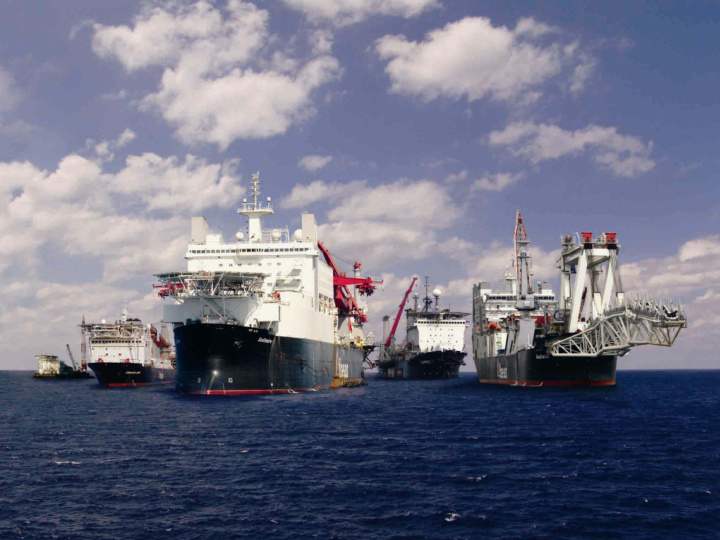



Positioning Solitaire From surface to seabed By Marco Kwanten Hydrographic Society Benelux Wednesday, 14 October 15
Allseas fleet Solitaire Audacia Lorelay Solitaire Audacia Lorelay Tog Mor Tog Mor Calamity Jane Pioneering Spirit Calamity Jane
Solitaire is the world’s largest pipelayer 5 Boeing 747-400s
Solitaire specification 397 m (1302 ft) Length (incl. stinger) : Length (excl. stinger) : 300 m (984 ft) (135 ft) Breadth : 41 m (459 ft) Stinger length : 140 m 120 m (394 ft) Minimum radius : Installed power : 51,500 kW (69,063 hp) Maximum speed : 13.5 knots (2315 kips) Tension capacity : 1050 t 2” to 60’’ Pipe diameters : Pipe storage : 22,000 t (661 kips) Multi-purpose crane : 300 t Accommodation : 420 persons
Tasked to lay pipe from A to B
From beach to fork
From subsea target box to target box
Avoiding ‘danger’ areas
Laying through tiny corridors
Crossing rock berms
Lay around pre-installed counteracts
Displacement initiator
Buckle initiators
Lay inside lay corridor
Requirements • Hardware • Software • Human touch
GNSS antenna locations Stinger cantilever Main mast Gantry mast
Main mast and gantry mast Two sets of 2x GNSS receivers with: • 2x L-band corrections (each) • 1x GNSS antenna (each) • Input from one of the 2 Inmarsat domes • QC computer • NTRIP corrections (Network Transport of RTCM data over IP)
GNSS setup
Heading During unguided lay, heading is very important. With a layback of 600 m in shallow waters, 0.4° heading difference (Octans precision of 0.1° seclat at 1 σ translated to 60°N at 2 σ ) amounts to a 4.2 m difference on the seabed. In deeper waters the layback may increase to several kilometres, but next to heading, the current starts playing a role. Corridors are usually wider in deeper waters.
On pipeline heading PPP heading shows 0.1° difference, roll induced as • height difference between antennas is 15 m LD7 heading is noisier that Octans heading • PPP heading is noisier than LD7 heading • Octans units do not seem to drift >0.05° from LD7 •
I n a curve PPP heading shows -0.2° difference, roll induced as • height difference between antennas is 15 m LD7 heading is noisier that Octans heading • PPP heading is noisier than LD7 • All 3 Octans units have different drift, but well • within their specs within this period
Stinger tip monitoring
ROV from support vessel
ROV on board Solitaire
Layback Layback is calculated from the bead stall to touchdown and is dependent on lay vessel tension: • Pipe parameters (wall thickness, coating, steel grade etc.) • Stinger settings (radius, departure angle) • Client/DNV criteria • Depth • Dynamics (shifting TD point) Varies from ~400 m to 3500 m
Online display
Helmsman display
ROV over pre-lay during touchdown monitoring
Polarled animation
Questions?
Recommend
More recommend